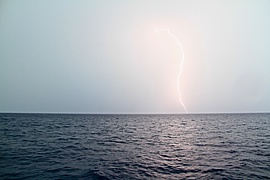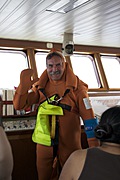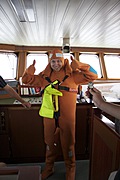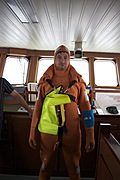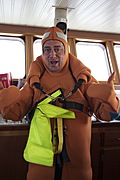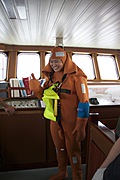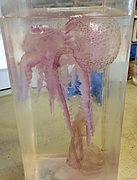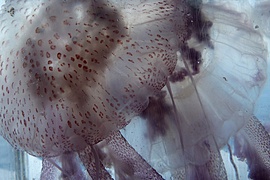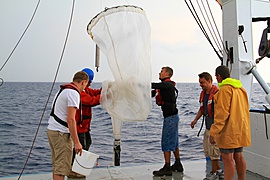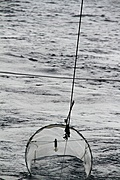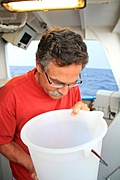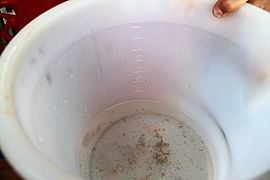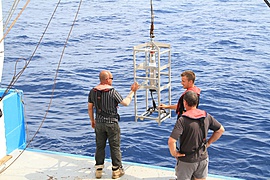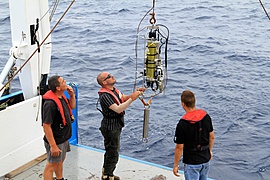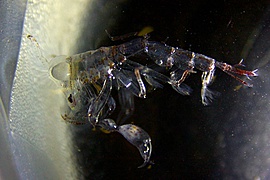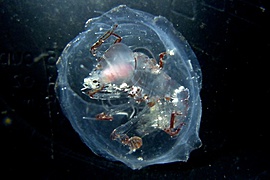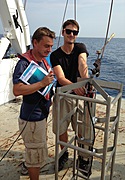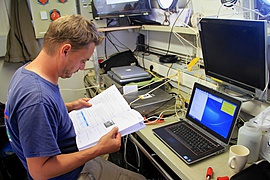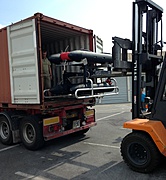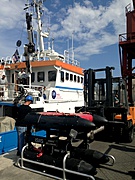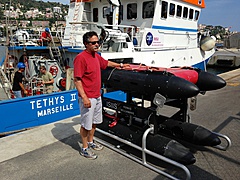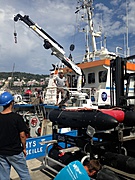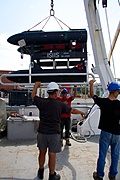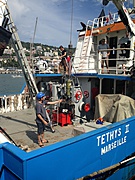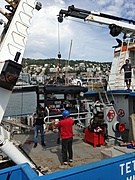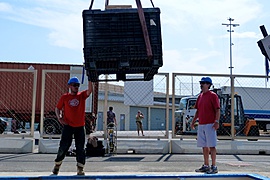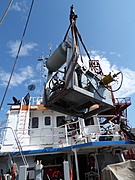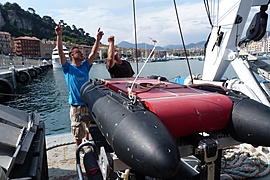VISUFRONT has started
by Jessica Luo, on
Thursday, July 18 marked the first day that we had ship time aboard the Tethys II. Tethys II is a CNRS vessel, serving multiple institutions' research and teaching activities in the Mediterranean. This year, this busy vessel only has 15 free days out of 356. Three UPMC teaching courses use the Tethys II (two Masters courses and one undergraduate course), as well as a whole suite of researchers. We had the fortune of securing ship time for 13 days for the VISUFRONT cruise. Our first task upon arriving in the morning was to go through the safety briefing, which included proving our competency in donning on all the safety gear, including the full immersion suit.
Due to the looming thunderclouds in the distance and the increasing frequency of lightening strikes, the science team happily went through the safety exercises, thinking – well, better safe than sorry. Shall we also note that at this point, it had not rained in Nice in over a month? What great timing these clouds had!
The VISUFRONT team showing their commitment to safety (Bob, Jean-Olivier, Robin, Cedric, and Jessica). Marie, from mon océan & moi came for the day to shoot pictures and we thought we would avoid her the embarrassment and not show hers ;)
But wait! More good news. We find out that due to French Navy activities, we would be restricted from sampling in French coastal waters (even beyond the typical naval activity zones) for three entire days during our 13 day cruise: Saturday through midnight Monday, July 20-22. There was only one other option: the small city-state of Monaco, whose narrow strip of waters were not controlled by the French Navy. But we would have to put a proposal in to Monaco and hope that it could be approved by Friday. Furthermore, because of the way that marine research permits are granted, even though we applied for these research permits more than half a year in advance, we would not find out until the week before whether or not we could sample during the next week. The whole cruise could be compromised. But ever the optimist, Jean-Olivier pressed on, assuring everyone it would be fine. Some of us wondered what he truly felt inside…
At that point in the morning, we were out of port, and since ISIIS was still on its way from Spain, we proceeded to sample with a Régent net along a transect from Nice towards the BOUSSOLE point (a buoy deployed by LOV which provides reference data for water-color satellites). The first few nets that we ran did not inspire the group with a whole lot of confidence, as the most interesting things we caught were a bunch of calycorphoran siphonophores, three adult Pelagia noctiluca, the purple-striped jellyfish, and some P. noctiluca ephyrae (young). Says Robin Faillettaz with a crinkle on his nose, "I think I am allergic to Pelagia."
The evening of the first day found us back in Nice harbor for a couple hours before leaving at 11 pm for BOUSSOLE to sample through the morning along a cross-front transect towards Nice. At each station, we sampled using a Régent net, CTD and the UVP. Vincent Taillandier, Research Engineer at LOV, joined us for the day to run the CTDs.
The only problem was, we could not get the UVP to work. After the first couple stations, we realized the problem was that the UVP had no power. But even with full power, we still could not consistently communicate with it to download the data. We knew that the data was being collected, because 10% of the time, we could actually connect with it and be able to download all the data it had collected. But there seemed to be no rhyme or reason to why it would or would not connect. We would need to contact Marc Picheral, who happened to be on a 6 month TARA cruise in the Arctic. There was an email address we could reach him at – as his ship in the Arctic had satellite internet – but we had no internet. Less than 20 km from the coast of France… We would have to wait until we were back in Nice to contact him.
Cédric and Robin trying to understand what is wrong with the UVP
We finished our transect and made a bee-line straight for the Port of Nice, as we had just received word that ISIIS had arrived in France and had gotten picked up by the truck to bring it to Nice. We wanted to meet the truck at the harbor when it arrived, so it would not turn back around and leave. Our 18-meter marine vessel was racing a 8-meter long truck to Nice. Go, go, go.
We arrive in Nice and voilà, the truck is there with ISIIS onboard. At the sight of ISIIS, all of us – particularly Cédric – look anxiously to see what condition it is in after its trans-Atlantic travel. From the surface, it looks good…
ISIIS and the accompanying gear being loaded on the the ship
We move ISIIS, the winch, and the computers from the shipping container on board the Tethys II. Thanks to Grigor Obolensky, from LOV, who organised everything with the staff of Nice's harbor, this is done in a swifty 30 minutes. To the lay person, nothing looks damaged. But Cedric, with his keen eye, notices that the container floor is littered with screws from the winch and ISIIS. Vibrations from the travel must have been so strong and sustained as to dislodge all these screws. At this point, no one had any clue how bad the damage would be. This was 5 pm on Friday afternoon.
To be continued…
